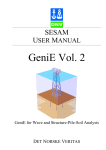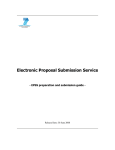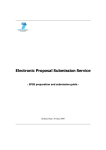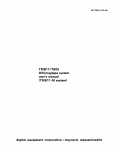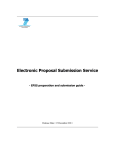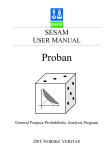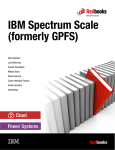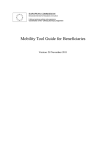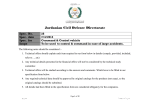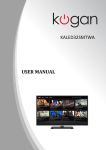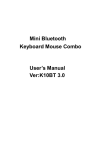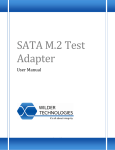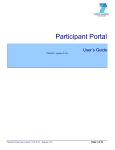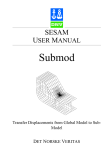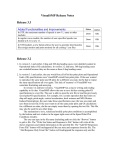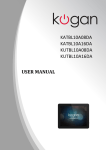Download Reporting Guidance Notes
Transcript
Research Executive Agency Unit P3 - Marie Curie Reintegration Grants and Researchers’ Night GUIDANCE NOTES ON PROJECT REPORTING European and International Reintegration Grants Marie Curie Actions Version 7.1 November 2010 Supporting documents can be downloaded from: http://cordis.europa.eu/fp7/find-doc_en.html CONTENTS 1. INTRODUCTION.............................................................................................................. 2 2. SUMMARY OF REPORTING REQUIREMENTS.......................................................... 3 3. FP7 IT REPORTING TOOLS ........................................................................................... 5 4. REPORTS .......................................................................................................................... 8 4.1 Periodic report and financial statement................................................................... 8 4.2 Mid-term review Report [only applicable to ERG > 24 months]......................... 10 4.3 Final report ........................................................................................................... 10 4.4 Questionnaires ...................................................................................................... 10 5. DECLARATION OF CONFORMITY............................................................................ 12 6. EVALUATION OF REPORTS AND PAYMENTS BY THE REA............................... 13 7. AMENDMENT REQUESTS........................................................................................... 14 8. NOTIFICATIONS – SUSPENSION/PART TIME REQUESTS.................................... 15 9. ANNEXES: Guidance Models......................................................................................... 16 Annex 1 Example of a Form C (IRG, Financial reporting after 24 months) ................... 16 Annex 2: Table "Explanation on the use of resources", page 6 of the Periodic Report... 17 1 1. INTRODUCTION On 14th of December 2007, the Commission decided1 to set up a Research Executive Agency (REA) charged with performing certain management tasks, within the guidelines established by the Commission for Executive Agencies. In this context, as of 15th of June 2009, and on the basis of powers delegated by the Commission, the Agency is carrying out all operations necessary for implementing those parts of the Community programmes entrusted to it, inclusive of the Marie Curie actions, and in particular those connected with the award and monitoring of grants. This Reporting Guidance document provides instructions to assist the beneficiaries in preparing the reports for Marie Curie Reintegration Grants: European Reintegration Grants (ERG) and International Reintegration Grants (IRG). It also describes the procedure for their submission to the REA. These Guidance notes do not supersede the rules and conditions laid out, in particular, in Council and Parliament Decisions relevant to the Seventh Framework Programme, the relevant Specific Programmes, the FP7 Rules for Participation, the Financial Regulation applicable to the general budget of the European Communities and its implementing rules, the Decisions setting up the REA, or the grant agreement and its annexes. The layout and content of the reports must conform to the instructions and guidance notes as established by the REA and the Commission, and transmitted to the REA by electronic means, using the electronic submission systems SESAM and FORCE, available via ECAS at http://ec.europa.eu/research/participants/portal/appmanager/participants/portal SESAM is the online reporting tool which allows the beneficiaries to upload the reports and questionnaires requested for the periodic and final reporting and FORCE is the online tool to fill in and submit electronically the financial statements (Forms C). The REA will evaluate project reports and disburse the corresponding payments within 105 days of their receipt2. 1 COMMISSION DECISION of 14 December 2007 setting up the ‘Research Executive Agency’ for the management of certain areas of the specific Community programmes People, Capacities and Cooperation in the field of research in application of Council Regulation (EC) No 58/2003; OJ L11, 15.01.2008 2 The deadlines are based on the time of arrival of the duly signed and stamped original paper version of the Form C. 2 2. SUMMARY OF REPORTING REQUIREMENTS ERG 2 to 3 years duration: 1 reporting period Start date Mid-term 1. End date Mid-term review report (for projects>24 months) 1. 2. Periodic report covering entire project (=1st period) Financial statement 3. 4. Final report Questionnaire IRG 2 to 4 years duration: 2 reporting periods∗ 2nd period 1st period Start date End date End 1st reporting period 1. 2. Periodic report covering the 1st period Financial statement 1. 2. 3. 4. Periodic report covering the 2nd period Financial statement Final report Questionnaire ∗Typically, the first reporting period is for the first 24 months and the second reporting period for the remainder. IRGs of 24 month duration will typically have one reporting period and will follow the ERG reporting scheme (without mid-term report). Please consult article 3 of your core grant agreement where the reporting periods are defined. 3 ERG projects (2 to 3 years duration) & IRG projects (2 years duration): Reports within 60 days after midterm within 60 days after the end of the project v Mid-term review report Periodic report: •Periodic report •Financial Statements: Form C v Final Report v Questionnaire v IRG projects (3 to 4 years duration): Reports Periodic report: •Periodic report •Financial Statements: Form C Final Report Questionnaire within 60 days after end of the reporting period within 60 days after the end of the project v v v v MID-TERM REVIEW REPORT (to be sent within 60 days after mid term for reporting periods of more than 24 months): to be filled in on-line in SESAM. No financial statement is required. PERIODIC REPORT (to be sent within 60 days after each reporting period as defined in the Article 3 of the grant agreement): to be filled in on-line in SESAM. A financial statement is required for the same period. FINAL REPORT (to be sent within 60 days after the end date of the project as defined in the Article 3 of the grant agreement): to be filled in on-line in SESAM. This report covers the period from month 1 to the end of the project. Please note that Reintegration Grants are exempt from submitting certificates on the financial statements (audit certificates) as they must be submitted for claims of interim payments and final payments when the Community financial contribution is equal to or superior to 375.000 Euro3. All above mentioned reports are only to be filled in on-line via SESAM as signed paper copies are no longer required. The Project Officer in the REA will be notified by email as soon as any of the reports is submitted in SESAM by a beneficiary4. The financial forms are to be filled on-line in the FORCE application (cf. below) and sent signed by regular mail. 3 4 See Article II.3.3 of the Annex II to the Marie Curie mono-beneficiary grant agreement. The payment deadlines are based on the time of arrival of the signed original paper version of the Form C. 4 3. FP7 IT REPORTING TOOLS The Research Participant Portal http://ec.europa.eu/research/participants/portal/appmanager/participants/portal In FP7, a growing number of interactions between beneficiaries and the Commission or the REA in the management of proposals and grants are made via the Participant Portal. The Portal is the unique platform for the IT project management. Currently, the services for legal entity registration, grant negotiation, amendments and financial and scientific reporting are already accessible from the Portal. More functions (eg. management of expertevaluators, proposal submission) will be made available in the future. The implementation of the concept of a unique platform requires an appropriate management of access rights, to provide each individual user access to the projects in which s/he is involved with the appropriate roles. Access is based on an ECAS (European Commission Authentication System) account for each user (physical person). Therefore in order to access the different services mentioned above, users have to login first via their ECAS account. The Portal applies the "single sign-on" approach (the ECAS registration is done only once). The unique identifier for a physical person in ECAS is her/ his e-mail address. 5 The Portal contact person for your project There is a Portal contact person for each individual project. By default, this role is allocated to the person whose contact details are given in the Proposal Submission Forms (under A2. 'Contact point'), which may be updated during the negotiation in the Grant agreement Preparation Forms (GPFs) in NEF as the 'administrative contact person'. S/He registers once and receives a login and a password. Then, s/he will manage the access rights to the project in the Portal via the "delegation of roles"5. How to find out who is the portal coordinator for your project? 1. If you are not sure who this person is for your project, please first verify in your Grant Agreement Preparation Forms (GPFs) who was named as contact person for administrative, legal and financial issues. This person is the Portal contact person for your project. Ask this person to go the portal and to grant you access to your project. 2. If this doesn't work or if you would like to change the Portal contact person, please contact the PO of your project. SESAM is the European Commission and REA online reporting tool, which allows for submission of documents related to the grant agreement, notably the mid-term, periodic and final reports. The beneficiary's contact person will thus use her/his ECAS6 log-in to access SESAM via the Participant Portal. After selection of the project, the following list will appear: Reports - Here you will find all reports related to the project (Mid-term for ERG, Periodic and Final) which have to be completed and submitted on-line. Documents - Here Declarations of Conformity are to be submitted. Amendment Requests - Here requests for amendments to the grant agreement are to be submitted. Notifications - This is the place where the beneficiaries should submit the following notifications: o Notification of the start date of the project (if this option is mentioned in the Article 3 of the grant agreement) o Notification of change of scientist-in-charge o Notification of contract suspension o Notification of fellow's change to part-time job o Notification of change of authorised representatives to sign the grant agreement o Notification of universal transfer of rights and obligations of beneficiary o Notification on change of address of beneficiary o Notification on change of beneficiary's legal entity name 5 Consult the Participant Portal on-line user manual: http://ec.europa.eu/research/participants/portal/ShowDoc/Participant+Portal/portal_content/help/participant_portal_usermanual_ version2.0.pdf 6 "European Commission Authentication Service" providing a unique access to all FP7 management IT tools. 6 Questionnaires - Here the fellows7 and scientists-in-charge should submit the following questionnaires: o Evaluation questionnaire o Follow-up questionnaire FORCE - FORCE is the web based application available to edit and submit electronically the FP7 financial statements (Form C – Annex VI to the grant agreement). Access to FORCE is given via the Participant Portal. Once you have access to your project, FORCE will automatically call up the appropriate Form C for your project, taking into account the instrument/funding scheme and the framework programme (FP7) under which your project falls. The Form C is partly pre-filled, containing the correct information of the grant, period concerned, and beneficiary. Please note that for Reintegration Grants, since they are paid as flat rates, the Form C is not used to declare costs but just to request the fixed amount corresponding to the concerned reporting period. For more information, see the Model Form C in section 9 of these guidance notes. More information on FORCE can be found in CORDIS website at the following address ftp://ftp.cordis.europa.eu/pub/fp7/docs/presentation-force_en.pdf If any problem should arise, please contact the Participant Portal technical helpdesk: [email protected] 7 There is no need for registration to fill in online questionnaires. The fellow will be requested to specify the grant agreement number only. 7 4. REPORTS 4.1 Periodic report and financial statement Periodic report As required in Article II.38 of the grant agreement, a periodic report must be submitted to the REA within 60 calendar days after the end of each reporting period (interim and final) as indicated in Article 3 of your grant agreement. The periodic report allows the REA to monitor (with the help of reviewers) the project and to compare its achievements with its stated objectives. To this end, progress should be compared as far as possible with Annex I of the grant agreement. The periodic report must be filled in and submitted electronically via SESAM. Please note that submission in any other format will not be accepted. No signed paper copy is required of this scientific report as, once submitted on-line, the report is deemed to be approved by the researcher and the scientist in charge. The report is pre-filled in SESAM with data (project number and acronym, PIC, duration of the period, administrative and scientific contact persons) from the Grant agreement Preparation Forms (GPFs), which were completed and approved by the beneficiary and the REA during the grant agreement negotiations. These data are not editable in SESAM. This report includes: • A publishable summary • An overview of the progress of work towards the objectives of the project, including achievements and attainment of any milestones and deliverables identified in Annex I. • The differences between work expected to be carried out in accordance with Annex I and the work actually carried out. • An explanation on the use of the resources. Explanation on the use of the resources For statistical purposes only (since the contribution is paid as a lump sum), in the section "Explanation on the use of the resources", the beneficiary is requested to provide the overall total costs of the project, whether direct or indirect, regardless the source of funding. This includes notably the total salary costs of the researcher, salary costs for other staff/researchers working on the project, costs of equipment, overheads, etc. Please see the model of a completed table on page 17 of these guidance notes. This periodic report is deemed to be approved by the scientist in charge and by the researcher on its submission via SESAM. This report is to be accompanied by a financial statement (Form C – see below) corresponding to the reporting period concerned. 8 Please refer to Article II.3 of the Annex II to the Marie Curie mono-beneficiary grant agreement. 8 Periodic financial statement (Form C) - Annex VI to the grant agreement Form C is the Annex VI to the grant agreement, common for all Marie Curie monobeneficiary schemes. The Form C is pre-filled with the information coming from the signed grant agreement (project number and acronym, PIC, period concerned). Beneficiaries cannot edit this information in the Form C. For the costs and requested EC contribution, ONLY the line "Lump sum/flat rate" in the column I "Other costs" should be completed by inserting the corresponding amount of flat rate in proportion to the duration in whole months of the reporting period as defined in Article 3 of your grant agreement. Please see an example of how a Form C has to be completed on page 16 of these Guidance notes. The amount cannot exceed the fixed amount per researcher-year according to the reference rates established in the Work Programme by funding scheme (for IRG, 25.000 Euros per year, and for ERG, 15.000 Euros per year)9. The concept behind the Reintegration Grants is that these are genuine flat rates which are not subject to verification on the basis of actual costs incurred. The Commission made an ex-ante assessment, when fixing these rates, that these do not generate profit. In principle they only cover a fraction of the cost of reintegrating the researcher (one should consider salary, infrastructure costs, etc. as described above) and are therefore meant to be only an encouragement to the beneficiary, not a full coverage of expenses. As such, the issue of actual spending is not relevant. The Form C is then used just to request the grant, not to declare costs. For IRG with two reporting periods, note that the total amount of the pre-financing and interim payments shall not exceed 90% of the maximum Community financial contribution defined in Article 4 of the grant agreement10. For ERG and IRG with only one reporting period there is only one payment after the end of the project when the reports have been approved. Flat rates in Form C must be declared in €. Form C must be filled in and submitted electronically∗ via FORCE. Please note that the submission in any other format will not be accepted (Word, PDF or Excel). When the Form C has been submitted in FORCE, it must be printed out, stamped and signed by the authorized person(s) within the beneficiary's organization and then sent to the REA. ∗Note that, for technical reasons, the Form C should be submitted twice electronically: first "to the coordinator" and immediately after, "to the EC". 9 Article III.9 of the Annex III to the Marie Curie Reintegration Grants. Article II.5.2 of the Annex II to the Marie Curie mono-beneficiary model grant agreement. 10 9 The original signed paper copy of Form C must be sent to the REA by regular mail to the address mentioned in the Article 7.1 of the grant agreement. Please note that the payment deadlines are based on the time of arrival of the duly signed and stamped original paper version of the Form C, following the electronic submission of the fully completed periodic report. 4.2 Mid-term review Report [only applicable to ERG > 24 months] In Article III.5 it is required that, in addition to the provisions of Article 3 and of Article II.3, for reporting periods of more than 24 months, the beneficiary must submit, within 60 days after the mid-term of the concerned reporting period, a scientific mid-term review report to assess the progress of the researcher activities. The mid-term review report is to be submitted electronically via SESAM and no signed paper copy is required as the report is deemed to be approved by both the scientist in and the researcher once submitted. No financial statement is submitted with the mid-term review report. 4.3 Final report At the end of the project, the host organization must submit a final report to the REA within 60 calendar days after the last day of the project as defined in Article 3 and II.3 of the grant agreement. The report contains: • a final publishable summary report covering results, conclusions and socio-economic impact of the project; • a report covering the wider societal implications of the project, including gender equality actions, ethical issues, efforts to involve other actors and spread awareness as well as the plan for the use and dissemination of foreground. This final report must be filled in on-line in SESAM, and it is deemed to be approved by the scientist in charge and by the researcher once submitted. No signed paper copy is required. This final report must be submitted together with the periodic report 11 (SESAM) and by the financial statement12 (FORCE) corresponding to the final reporting period. 4.4 Questionnaires 11 12 Please refer to page 6. Please refer to page 6. 10 The beneficiary must commit him/herself to complete in SESAM the evaluation and followup questionnaires referred to in points h) and i) of Article III.2 of the grant agreement: The beneficiary must take measures to ensure that the researcher completes the evaluation questionnaires, provided by the REA in SESAM, at the end of the project; The beneficiary must contact the researcher two years after the end of the project in order to invite him/her to complete the follow-up questionnaire, provided by the REA in SESAM. As stated in Article III.213, the beneficiary must also record and update, for at least three years after the end of the project, the contact details of the researcher. These questionnaires are available in SESAM. 13 Please refer to Article III.2.h) of the Annex III to the Marie Curie Reintegration Grants. 11 5. DECLARATION OF CONFORMITY According to article III.3 of the Annex III of the grant agreement, the beneficiary is obliged to submit, by electronic means in SESAM, a declaration on the conformity of the agreement concluded between the beneficiary and the researcher with the grant agreement, within 20 days of either of the following dates (whichever comes later): The appointment of the researcher; The start of the date of the project; The entry into force of the grant agreement. The declaration should follow the layout and procedures that will be communicated by the REA (see Annex 3 to this guide). The declaration should be submitted via SESAM, printed out, duly signed by the authorised representative of the beneficiary* and sent to the REA by regular mail to the address in Article 7.1 of the grant agreement. *Note: This Declaration of Conformity can be signed by a person other than the legal representative indicated in the grant agreement only if this person has been authorised, for instance, through a mandate or a signatory empowerment, to sign on behalf of the legal representative. 12 6. EVALUATION OF REPORTS AND PAYMENTS BY THE REA The REA will evaluate project reports and deliverables and disburse the corresponding payments within 105 calendar days14 of their receipt15 unless the time-limit or the project has been suspended16. Payments will be made after the REA's approval of reports. The approval of the financial statements and the reimbursement of the corresponding EU contribution are subject to the prior approval of the periodic reports. The absence of a response from the REA within the 105 days time-limit shall not imply its approval. However, the REA should send a written reply to the beneficiary. The REA may reject reports even after the time-limit for payment. Approval of the reports does not imply exemption from audits or reviews17. After reception of the reports the REA may: a) approve the reports, in whole or in part or make the approval subject to certain conditions; b) reject the reports by giving an appropriate justification and, if appropriate, start the procedure for termination of the grant agreement in whole or in part; c) suspend the time limit if one or more of the reports have not been supplied, or are not complete or if some clarification or additional information is needed or there are doubts concerning the financial statement and/or additional checks are being conducted. The suspension will be lifted from the date when the last report, deliverable or the additional information requested is received by the REA. The REA will inform the beneficiary of any such suspension and the conditions to be met for the lifting of the suspension. Suspension shall take effect on the date when notice is sent by the REA. At the end of the project, the REA may decide not to make the payment of the corresponding EU financial contribution subject to one month's written notice of non-receipt of a report, of a certificate on the financial statements or of any other project deliverable. 14 Article II.4 and Article II.5 of the Annex II to the Marie Curie mono-beneficiary model grant agreement. The deadlines are based on the time of arrival of the duly signed and stamped original paper version of the Form C. 16 Article II.7 of the Annex II to the Marie Curie mono-beneficiary model grant agreement. 17 The REA or the Commission may, at any time during the implementation of the project and up to five years after the end of the project, arrange for technical or financial audits to be carried out, by REA, external auditors, or by the Commission services including OLAF (Articles II.20 and II.21 of the Annex II to the Marie Curie mono-beneficiary model grant agreement). For more information on audits, please see the MC financial guidelines in CORDIS. 15 13 7. AMENDMENT REQUESTS Amendments18 to the grant agreement should be considered as exceptional measures to reflect severe changes in conditions of the original grant agreement. Amendments such as change of banking details or legal data of the beneficiary need to be implemented as soon as possible. Other requests will be accepted only in exceptional and duly justified cases and are subject to prior discussion with the Project Officer. Any amendment request should only be submitted to the REA after consultation with the Project Officer, duly signed by the beneficiary's authorised representative. For amendments please refer to the Amendments Guide for FP7 Grant agreements available on ftp://ftp.cordis.europa.eu/pub/fp7/docs/amendments-ga_en.pdf. An REA version will be published soon. In the SESAM menu 'Amendment Requests' the beneficiary selects the type of amendment to be submitted. Having completed the form, the beneficiary can save it, add attachments or submit. The final amendment should be submitted via SESAM, printed out, signed by the authorised legal representative, stamped and sent duly signed to the REA by registered mail. All signed requests for amendments must be sent to the address mentioned in article 7.1 of the grant agreement. The Project Officer in the REA will be notified by email as soon as an amendment request is submitted in SESAM by the beneficiary. There are 4 possible types of status of amendment in SESAM: Submitted – when the coordinator submits the amendment in SESAM; Validated – when the REA approves the amendment; Rejected – when the REA rejects the amendment; Implemented – when amendment is uploaded in the all internal IT systems. The beneficiary will be notified by email whenever the status of the amendment is changed. 18 See Articles II.31 and II.32 of the Annex II to the Marie Curie mono-beneficiary grant agreement. 14 8. NOTIFICATIONS – SUSPENSION/PART TIME REQUESTS Notifications There are different types of notifications, signed by the legal representative of the beneficiary, which can be submitted to the REA: Notification of the start date – This option can be used ONLY in the case that it is mentioned in article 2 of the grant agreement; Notification of change of scientist in charge – If the Project Officer does not advise otherwise, the CV of the new scientist in charge should be attached to this notification. Notification of change of authorised representatives to sign the grant agreement – If this is not notified, the legal documents related to the grant in which the signature does not correspond to the authorised representative in the grant agreement will not be receivable. Notification of universal transfer of rights and obligations of beneficiary – This implies that the entity to which the beneficiary universally transfers the rights and obligations will automatically become the counterpart of the grant agreement. The Project Officer should be notified to update the grant accordingly. Notification on change of address of beneficiary – This change is to be addressed to the URF/FP7 validation team. Notification of change of beneficiary's legal entity name - This change is to be addressed to the URF/FP7 validation team. The final notification should be submitted via SESAM, printed out, signed by the legal representative and sent duly signed to the REA by regular mail to the address mentioned in article 7.1 of the grant agreement. The Project Officer in the REA will be notified by email as soon as any notification is submitted in SESAM by the beneficiary. Suspensions and change of time dedicated to the project In principle, the period of the stay of the researcher at the beneficiary’s institution should not be interrupted and he/she should be working full time. However, the beneficiary must immediately inform the REA of any event affecting or delaying the implementation of the project19 and s/he can propose to suspend part, or all, of the project, or change the time dedicated to it (e.g. from full to part time) if: Force majeure or exceptional circumstances render the execution of the project excessively difficult or uneconomic (article II.7.2); Due to personal, family (including maternity/parental leaving) or professional reasons of the researcher not foreseen in Annex I of the grant agreement (article III.4.1) the implementation is, or may be, delayed. 19 Article II.7.1 to the Marie Curie mono-beneficiary model grant agreement 15 9. ANNEXES: Guidance Models Annex 1 Example of a Form C (IRG, Financial reporting after 24 months) 16 Annex 2: Table "Explanation on the use of resources", page 6 of the Periodic Report Example how this page could be completed, showing the total costs of the project. Note that this information is collected for statistical purposes only: PERSONNEL, SUBCONTRACTING AND OTHER MAJOR COST ITEMS FOR [NAME OF HOST INSTITUTION]: 20 Amount Explanations Salary of the researcher Other personnel costs Subcontracting20 Travel costs 153.000 51.000 4.500 Salary of the researcher Salary of PhD candidates Equipment Overheads Other items Total 14.200 25.000 2.000 249.700 Attendance at two conferences, paper presentation Laboratory equipment Printing and publication costs Only applicable if foreseen in the Annex I to the grant agreement 17




















